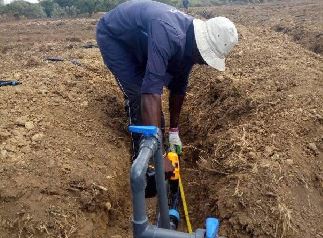Prime
How pump installation depth pushes more water to farms

A farmer takes measurements before installing a water pump. Photo | Courtesy
What you need to know:
- To farm profitably one requires a reliable and affordable water source or supply for irrigation. This is because water plays a crucial role in determining whether one will harvest losses or profits.
Uphill farmers can pump more water from rivers at no cost by increasing the depth of installation of the self-priming drum pump at the base of the stream.
The pump from Vintage Greens Limited does not require any form of energy besides the force of running water.
But its effectiveness depends on how deep it has been installed for the falling water to build enough pressure from its pipes for further pushing.
Effectiveness
Vintage chief executive officer Elijah Njoroge said the pump pushes water in multiples of five metres in relation to its depth.
For instance if it is installed three metres down the water fall or an artificial hole, it pushes water to a tank at a height of 15 metres. On average, it can deliver 5,000 litres per day to the farm.
From the collection tank, the water can be delivered to the farm via pipes. “It is a simple way of harnessing gravity from the falling water to power the pumping process. This ensures that farmers do not incur costs in pumping water for farm use when they can use what nature has provided,” Njoroge said.
How it works
The pump works by alternating valves that open and close at different occasions. The closing causes a build-up of pressure within the pipes to thrust out the water to other chambers before being pushed out to the tank delivery exit.
It is an improved and cheaper form of hydram pumps. Besides the purchase and installation costs, the farmer does not incur other expenses in electricity or fuel bills if they have a river with constant flow of water.
It is also a way of cutting pollution using available energy, which is also environmental friendly. Off the grid farmers have the opportunity to access water for irrigation and other farm operations.
Factors
Now that we have a clear understanding of the different types of water pumps let’s delve into the key factors you should consider when selecting the best water pump for irrigation.
Water requirements
Determining your specific water requirements is the first step in choosing a water pump. Consider the size of your irrigation area and the amount of water needed to adequately irrigate your crops. This will help you determine the flow rate and pumping capacity required for your pump.
Power source
The power source for your water pump is an important consideration. Evaluate the availability of electricity, sunlight, or fuel in your area. If electricity is accessible, electric or solar-powered pumps are viable options. Diesel or petrol-powered pumps may be more suitable in remote areas with limited electricity.
Pressure requirements
Your irrigation system’s head and pressure requirements play a crucial role in pump selection. The head refers to the vertical distance between the water source and the highest point of irrigation. Consider the elevation and distance your pump needs to lift water to ensure it can meet the required pressure and head specifications.
Flow rate
The flow rate of a water pump represents the amount of water it can deliver in a given duration. It is usually measured in cubic meters per hour (m3/h) or gallons per minute (GPM). A higher flow rate means the pump can deliver more water in the same time frame. The flow rate required for your irrigation needs will depend on factors such as the size of the area to be irrigated and the water demand of the crops or plants.
Durability
Investing in a durable and reliable water pump is essential for long-term performance. Look for pumps made with high-quality materials that can withstand the harsh conditions of agricultural use. Read customer reviews and consider reputable brands known for their reliability and longevity.
Maintenance
Regular maintenance is crucial for ensuring the optimal performance of your water pump. Choose a pump that is easy to clean, maintain, and repair. Consider the availability of spare parts and technical support in your area. Opt for pumps with user-friendly designs and easily accessible components.
How it works
The pump works by alternating valves that open and close at different occasions. The closing causes a build-up of pressure within the pipes to thrust out the water to other chambers before being pushed out to the tank delivery exit.




